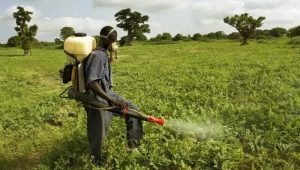Challenging Misleading Narratives: Unmasking the Hazards
Crops have been exposed to different chemicals, such as pesticides and fertilisers, during the stages of cultivation, storage, and food preparation since the 19th century. While there is no denying that these herbicides have increased agricultural yields, a sobering number highlights their consequences: an average of 200,000 documented fatalities per year worldwide. This cost is particularly noticeable in poor countries, where issues such as improper use of pesticides, overexposure, and inadequate regulation continue to exist.

Various stakeholders, including practitioners, farmers, communities, agrochemical companies, investors, and nations, are reassessing and diversifying their agricultural investments and practices in response to this concerning scenario. Embracing nature-based farming practices like organic farming, biopesticides, agroecology, integrated pest management (IPM), and home food growing are all part of this change. The goal is to reduce or completely eradicate the use of pesticide mixtures in food, resulting in better environments, healthier lifestyles, and sustainable earnings.
Persistent proponents and advocates continue their lobbying efforts in spite of the well-established risks linked to chemical pesticides in water, air, soil, markets, food, and the environment at large – particularly those that are labelled as Highly Hazardous Pesticides (HHPs) or that are under investigation or ban by international regulatory bodies. Instead of making investments in safer alternatives, their objective is to assure the continuous use of these dangerous compounds for financial advantage, even at the expense of maintaining an annual toll of over 200,000 fatalities and aggravating health issues.
Efforts to impose strict and accountable regulations on the import, trade, manufacture, promotion, and use of agrochemical products in Nigeria have faced resistance from these promoters. Counter arguments from associations of big industry agrochemical player push narratives such:
- Life itself is hazardous, including the water we drink
- Should we revert to using horses and donkeys instead of cars to lower carbon emissions?
- What causes cancer abroad may not cause cancer in Nigeria
- Pharmaceuticals have side effects, yet the world relies on them
- There are no alternatives; the government needs to provide alternatives.
While a tiny fraction of these arguments holds little truth, for instance, life itself is not a hazard but can be exposed to risks. The call for responsible use of agrochemicals in Africa faces challenges due to a lack of affordability and understanding of safety measures. Government agencies lack the capacity and political support to regulate the industry effectively, resulting in food safety crises, rising cases of cancer, kidney diseases, and a decline in life expectancy.

Arguments defending the use of highly toxic agrochemicals often oversimplify the risks involved, neglecting the varying degrees of toxicity among chemicals. Unlike pharmaceuticals, agrochemical manufacturers often do not disclose the full risks associated with their products. Farmers and consumers lack the right to know the contents and impact of the chemicals they use or are exposed to. For instance, the AAPN and Smallholder Women Farmers Association of Nigeria (SWOFON) survey of 2022, shows that over 80% of surveyed farmers do not know the pesticide active ingredients in the brands they use on their crops, or the health implication of the active ingredients.
While promoting responsible choices in the use of agrochemicals, it is essential to counter the narrative that safer alternatives do exist in Nigeria. Many farmers even in Nigeria are successfully growing food without highly toxic pesticides, utilizing traditional pest control methods and nature-based alternatives, and Integrated Pest Management systems (IPM).
The Reality of Pesticide Dangers – A Collective Call to Action
Challenging misleading narratives requires evidence-based advocacy, particularly when addressing the pervasive dangers of pesticides. To illuminate the gravity of the situation, concerned stakeholders in Nigeria compiled a comprehensive dossier at the end of 2023. This dossier, prepared by the Alliance for Action on Pesticide in Nigeria (AAPN) and the Health of Mother Earth Foundation (HOMEF), serves to inform consumers, farmers, investors, and government entities about the status of pesticide active ingredients in Nigeria. The aim is to guide choices, influence investment decisions, shape government policies, and empower the rights of consumers and farmers in selecting agrochemical products.
According to the Pesticide Dossier Volume One (I), detailing 670 brands traded and used in Nigeria, 30 pesticide active ingredients were identified. Shockingly, 25 of these are categorized as Highly Hazardous Pesticides (83.3%), three as Moderately Hazardous Pesticides, one as Slightly Hazardous Pesticide, and the last as a pesticide unlikely to present acute hazard.
The dossier’s revelations are alarming:
Cancer-Causing Pesticides (18 chemicals, 60%)
Most of these pesticide active ingredients that have been scientifically proven and in some cases have medical reports and even court cases linking them to causing increase incidents of tumors of the pancreas, mammary glands, thyroid glands and prostate glands and in some case weakening of bone marrow. Most of them have clearly been categorised as – “carcinogenic” or most “possible human carcinogenic” by leading organisations, institutions and authorities.
Nigeria records over 120,000 new cancer cases yearly. According to the Breast Cancer Prevention Partners (BCPP) a USA cancer focused organisation and the AAPN Dossier, exposure to the pesticides and herbicides like DDT, Glyphosate, Chlorpyrifos, Atrazine, Dieldrin & Aldrin, Dimethoate, Endosulfan, Tetramethrin, Diuron, Acephate, Cypermethrin, Dichlorvos (DDVP), etc especially during critical periods of breast development such as prenatally and in early childhood, is associated with an increased risk for developing breast cancer. Most of these pesticide active ingredients that have been scientifically proven and, in some cases, have medical reports and even court cases linking them to causing increase incidents of tumors of the pancreas, mammary glands, thyroid glands and prostate glands and in some case weakening of bone marrow.
Most of them have clearly been categorised as – “carcinogenic” or most “possible human carcinogenic” by leading organisations, institutions and authorities. From the dossier these active ingredients labelled cancer causing and/or possible carcinogen are – DDT (Dichlorodiphenyltrichloroethane), Glyphosate, Chlorpyrifos, Atrazine, Dieldrin & Aldrin, Dimethoate, Endosulfan, Tetramethrin, Diuron, Acephate, Cypermethrin, and Dichlorvos (DDVP).
Endocrine Disruptors (22 chemicals, 73%)
Endocrine disruptors interfere with the normal functioning of the endocrine system, which regulates hormones controlling various bodily functions, including mood, growth, metabolism, and reproduction. They interferes with the normal functioning of the endocrine system. The endocrine system is made up of glands that make hormones. The endocrine hormones help control mood, growth, and development, the way our organs work, metabolism, and reproduction. The endocrine system regulates how much of each hormone is released. The endocrine system influences almost every cell, organ, and function of our bodies. If the endocrine system is not healthy, one might have problems developing during puberty, getting pregnant, or managing stress.
One might also gain weight easily, have weak bones, or lack energy because too much sugar stays in your blood instead of moving into your cells where it is needed for energy. These endocrine disrupting pesticide active ingredients include; Carbofuran, Cypermethrin, Dichlorvos (DDVP), Dimethoate, Endosulfan, Lambda-Cyhalothrin, Permethrin, Profenofos, Triazophos, Atrazine, Butachlor, Diuron, Glyphosate, Paraquat, Pendimethalin, Propanil, Quizalofop-Ethylene, Carbendazim, Hexaconazole, Mancozeb and Propineb.
Immunotoxins (19 chemicals, 63%)
Immunotoxins are substances that adversely affect the immune system, potentially leading to increased susceptibility to infectious diseases. Immunotoxicity leads to the increased incidence or severity of infectious diseases. These immunotoxic pescticides include; Carbofuran, Cypermethrin, Endosulfan, Imidacloprid, Lambda-Cyhalothrin, Permethrin, Tetramethrin, Thiamethoxam, Triazophos, Atrazine, Butachlor, Diuron, Glyphosate, Paraquat, Pendimethalin, Propanil, Carbendazim, and Mancozeb.
Neurotoxic Pesticides (18 chemicals, 60%)
Neurotoxic pesticides have adverse effects on the central and/or peripheral nervous system, causing damage to the brain and nerves. Symptoms may appear immediately or be delayed after exposure to these pesticides. Some of these symptoms include limb weakness or numbness, loss of memory, vision, and/or intellect, uncontrollable obsessive and/or compulsive behaviors, delusions, headache, cognitive and behavioral problems, learning disability, and muscle twitching, tremors, convulsion, paralysis, Parkinson disease, etc. some of these pesticide active ingredients include Abamectin, Acephate, Carbofuran, Chlorpyrifos, Cypermethrin, Dichlorvos (DDVP), Dimethoate, Endosulfan, Lambda-Cyhalothrin, Permethrin, Profenofos, Triazophos, Butachlor, Diuron, Glyphosate, Paraquat, Pendimethalin, and Carbendazim.
Reproductive Toxic Pesticides (18 chemicals, 60%)
Fertility and nutrition are closely linked to each other. The consumption of food containing traces of pesticides or general exposure to certain pesticides could cause alterations in the reproductive system. Reproductive toxic pesticides can cause harm to the reproductive system, leading to issues such as miscarriages, birth defects, and low birth weights. From a study, published in the Environmental Health Perspectives in 2023, included data from more than 1,700 men and spanned several decades – Researchers compiled, rated and reviewed the results of 25 studies of certain pesticides and male fertility and found that men who had been exposed to certain classes of pesticides had significantly lower sperm concentrations. These pesticide active ingredients include Abamectin, Carbofuran, Chlorpyrifos, Cypermethrin, Dimethoate, Endosulfan, Imidacloprid, Permethrin, Profenofos, Thiamethoxam, Atrazine, Diuron, Glyphosate, Quizalofop-Ethylene, Carbendazim, Mancozeb, and Propineb.
These examples illustrate the alarming prevalence of hazardous chemicals in various pesticide categories, underscoring the urgent need for informed action and the adoption of safer alternatives. Stakeholders must prioritise phasing out these hazardous pesticides, allocating budgets, encouraging private investments, and promoting regulations supporting safe alternative farm inputs. Training on organic, Integrated Pest Management (IPM), and agroecological methods must be prioritised, especially considering that over 70% of farming and food production is carried out by small-scale farmers.
While the majority of these hazardous pesticide active ingredients are banned in more developed countries, they continue to be exported to vulnerable developing nations like Nigeria. This underscores the need for collective responsibility and accountability among stakeholders to protect the interests and well-being of all Nigerians. Regardless of differing perspectives, the consequences of pesticide exposure are indiscriminate, emphasising the importance of safeguarding Nigeria and Africa collectively.
By Donald Ikenna Ofoegbu, Coordinator, Alliance for Action on Pesticide in Nigeria (AAPN), allianceforactiononpesticidesng@gmail.com, ikennadonald@gmail.com
